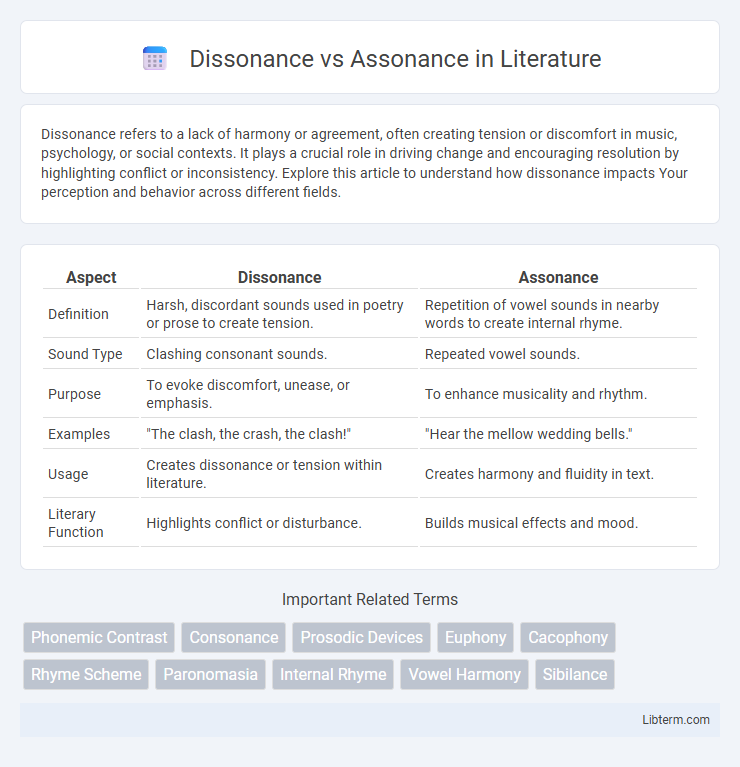Dissonance refers to a lack of harmony or agreement, often creating tension or discomfort in music, psychology, or social contexts. It plays a crucial role in driving change and encouraging resolution by highlighting conflict or inconsistency. Explore this article to understand how dissonance impacts Your perception and behavior across different fields.
Table of Comparison
| Aspect | Dissonance | Assonance |
|---|---|---|
| Definition | Harsh, discordant sounds used in poetry or prose to create tension. | Repetition of vowel sounds in nearby words to create internal rhyme. |
| Sound Type | Clashing consonant sounds. | Repeated vowel sounds. |
| Purpose | To evoke discomfort, unease, or emphasis. | To enhance musicality and rhythm. |
| Examples | "The clash, the crash, the clash!" | "Hear the mellow wedding bells." |
| Usage | Creates dissonance or tension within literature. | Creates harmony and fluidity in text. |
| Literary Function | Highlights conflict or disturbance. | Builds musical effects and mood. |
Introduction to Dissonance and Assonance
Dissonance involves the use of harsh, discordant sounds to create tension or discomfort, often through clashing consonants and irregular rhythms. Assonance is the repetition of vowel sounds within nearby words, producing a melodic or harmonious effect that enhances the mood and flow of a text. Both devices play crucial roles in poetry and prose by influencing the auditory experience and emotional impact on the reader.
Defining Dissonance in Language and Literature
Dissonance in language and literature refers to the deliberate use of harsh, discordant sounds or words to create a jarring effect that disrupts the flow of a passage. This technique contrasts with assonance, which emphasizes vowel sound repetition for harmony and musicality. Dissonance enhances emotional intensity, evokes tension, and highlights conflict within texts, making it a powerful tool in poetry and prose.
Understanding Assonance and Its Effects
Assonance is the repetition of vowel sounds within nearby words, creating internal rhyme and enhancing the musical quality of language. This phonetic device intensifies mood and emotion by emphasizing particular sounds, which can make poetry and prose more memorable and engaging. Understanding assonance helps writers manipulate tone and rhythm to evoke subtle sensory responses in readers.
Key Differences Between Dissonance and Assonance
Dissonance involves the intentional use of harsh, discordant sounds to create a sense of tension or discomfort, often employing consonant clusters and awkward rhythms in poetry or music. Assonance is characterized by the repetition of vowel sounds within nearby words to create internal rhyming and enhance musicality or mood. The key difference lies in dissonance's focus on clashing sounds for effect, whereas assonance emphasizes harmonious vowel repetition to produce a melodic quality.
Historical Origins and Literary Contexts
Dissonance and assonance both have roots in classical rhetoric and poetics, with dissonance emerging as a technique to create tension and disruption through harsh, jarring sounds, while assonance involves the repetition of vowel sounds to produce harmony and musicality in language. Ancient Greek and Roman literature often employed these sound devices to enhance emotional impact and underscore thematic elements within poetry and drama. Over time, these techniques evolved in various literary traditions, influencing contemporary poetry and prose by shaping rhythm, mood, and auditory experience.
How Dissonance Impacts Tone and Mood
Dissonance in literature creates a harsh, jarring effect that intensifies tension and discomfort, significantly shaping the tone to feel uneasy or chaotic. This sonic clash disrupts the reader's expectations, often evoking feelings of conflict, anxiety, or distress that deepen the overall mood. By contrasting with smoother sounds like assonance, dissonance emphasizes emotional discord and amplifies the narrative's dramatic impact.
Assonance’s Role in Creating Musicality
Assonance plays a crucial role in creating musicality by repeating vowel sounds within nearby words, enhancing the rhythm and flow of a poem or song. This technique softens the auditory experience, producing harmony and melody that enrich the listener's engagement. Unlike dissonance, which introduces tension through clashing sounds, assonance promotes smoothness and continuity, making the composition more pleasing to the ear.
Famous Examples of Dissonance and Assonance
Famous examples of dissonance in literature include the harsh, jarring sounds in Dylan Thomas's "Do not go gentle into that good night," which create a sense of tension and urgency. For assonance, Edgar Allan Poe's poem "The Bells" is renowned for its repetitive vowel sounds like "bells" and "tells," enhancing the musicality and mood. Shakespeare's works frequently employ both techniques; for instance, in Macbeth, dissonance builds unease, while assonance in sonnets adds lyrical harmony.
Practical Tips for Using Both in Your Writing
Incorporate dissonance by using harsh, jarring consonant sounds to create tension or emphasize conflict in your writing, especially in scenes of chaos or emotional turmoil. Use assonance by repeating vowel sounds to add musicality and rhythm, enhancing mood or emotional resonance in poetry and prose. Balance both techniques strategically to intensify atmosphere and engage readers without overwhelming the narrative flow.
Conclusion: Choosing Between Dissonance and Assonance
Choosing between dissonance and assonance depends on the desired emotional impact and auditory effect in a text. Dissonance creates tension and unease by using harsh or clashing sounds, ideal for themes of conflict or discomfort, while assonance enhances musicality and fluidity through repeated vowel sounds, suited for conveying harmony and mood. Writers leverage dissonance for dramatic emphasis and assonance for lyrical resonance, tailoring sound devices to the tone and purpose of their work.
Dissonance Infographic

 libterm.com
libterm.com